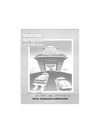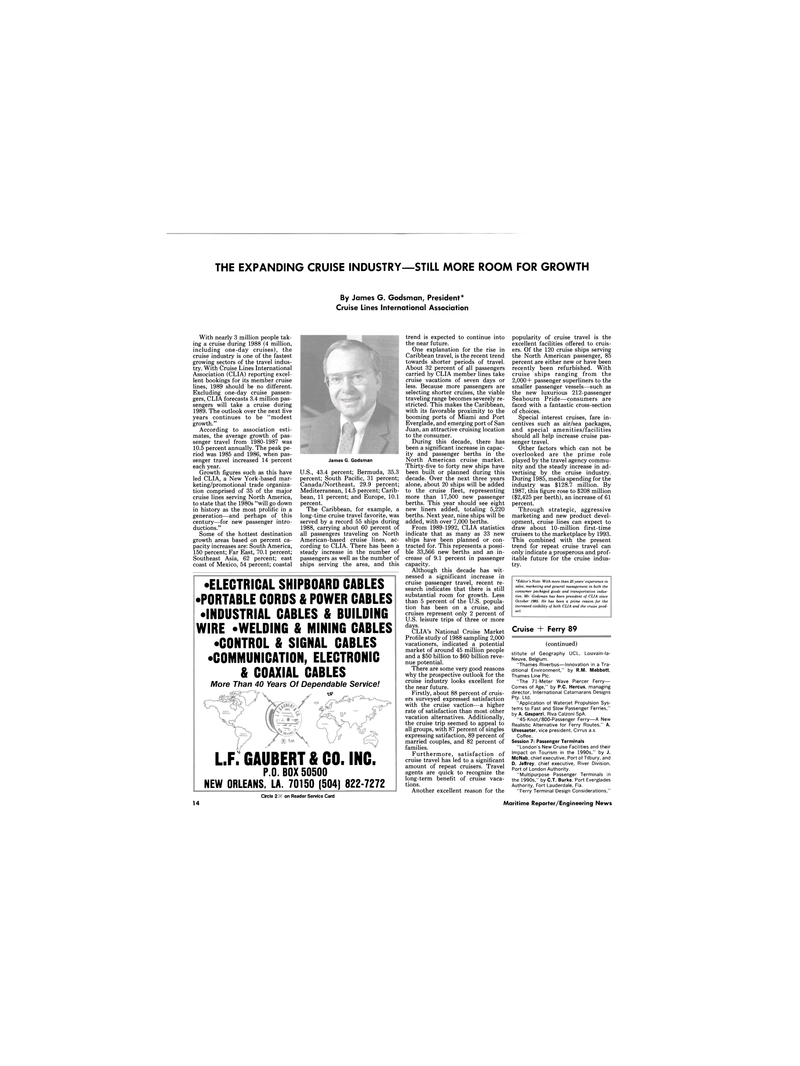
Page 12: of Maritime Reporter Magazine (May 1989)
Read this page in Pdf, Flash or Html5 edition of May 1989 Maritime Reporter Magazine
THE EXPANDING CRUISE INDUSTRY—STILL MORE ROOM FOR GROWTH
By James G. Godsman, President*
Cruise Lines International Association
With nearly 3 million people tak- ing a cruise during 1988 (4 million, including one-day cruises), the cruise industry is one of the fastest growing sectors of the travel indus- try. With Cruise Lines International
Association (CLIA) reporting excel- lent bookings for its member cruise lines, 1989 should be no different.
Excluding one-day cruise passen- gers, CLIA forecasts 3.4 million pas- sengers will take a cruise during 1989. The outlook over the next five years continues to be "modest growth."
According to association esti- mates, the average growth of pas- senger travel from 1980-1987 was 10.5 percent annually. The peak pe- riod was 1985 and 1986, when pas- senger travel increased 14 percent each year.
Growth figures such as this have led CLIA, a New York-based mar- keting/promotional trade organiza- tion comprised of 35 of the major cruise lines serving North America, to state that the 1980s "will go down in history as the most prolific in a generation—and perhaps of this century—for new passenger intro- ductions."
Some of the hottest destination growth areas based on percent ca- pacity increases are: South America, 150 percent; Far East, 70.1 percent;
Southeast Asia, 62 percent; east coast of Mexico, 54 percent; coastal
James G. Godsman
U.S., 43.4 percent; Bermuda, 35.3 percent; South Pacific, 31 percent;
Canada/Northeast, 29.9 percent;
Mediterranean, 14.5 percent; Carib- bean, 11 percent; and Europe, 10.1 percent.
The Caribbean, for example, a long-time cruise travel favorite, was served by a record 55 ships during 1988, carrying about 60 percent of all passengers traveling on North
American-based cruise lines, ac- cording to CLIA. There has been a steady increase in the number of passengers as well as the number of ships serving the area, and this •ELECTRICAL SHIPBOARD CABLES •PORTABLE CORDS & POWER CABLES •INDUSTRIAL CABLES & BUILDING
WIRE *WELDING & MINING CABLES •CONTROL & SIGNAL CABLES •COMMUNICATION, ELECTRONIC & COAXIAL CABLES
More Than 40 Years Of Dependable Service! ts>
LF: GAUBERT & co. INC.
P.O. BOX 50500
NEW ORLEANS, LA. 70150 (504) 822-7272 trend is expected to continue into the near future.
One explanation for the rise in
Caribbean travel, is the recent trend towards shorter periods of travel.
About 32 percent of all passengers carried by CLIA member lines take cruise vacations of seven days or less. Because more passengers are selecting shorter cruises, the viable traveling range becomes severely re- stricted. This makes the Caribbean, with its favorable proximity to the booming ports of Miami and Port
Everglade, and emerging port of San
Juan, an attractive cruising location to the consumer.
During this decade, there has been a significant increase in capac- ity and passenger berths in the
North American cruise market.
Thirty-five to forty new ships have been built or planned during this decade. Over the next three years alone, about 20 ships will be added to the cruise fleet, representing more than 17,500 new passenger berths. This year should see eight new liners added, totaling 5,220 berths. Next year, nine ships will be added, with over 7,000 berths.
From 1989-1992, CLIA statistics indicate that as many as 33 new ships have been planned or con- tracted for. This represents a possi- ble 33,566 new berths and an in- crease of 9.1 percent in passenger capacity.
Although this decade has wit- nessed a significant increase in cruise passenger travel, recent re- search indicates that there is still substantial room for growth. Less than 5 percent of the U.S. popula- tion has been on a cruise, and cruises represent only 2 percent of
U.S. leisure trips of three or more days.
CLIA's National Cruise Market
Profile study of 1988 sampling 2,000 vacationers, indicated a potential market of around 45 million people and a $50 billion to $60 billion reve- nue potential.
There are some very good reasons why the prospective outlook for the cruise industry looks excellent for the near future.
Firstly, about 88 percent of cruis- ers surveyed expressed satisfaction with the cruise vaction—a higher rate of satisfaction than most other vacation alternatives. Additionally, the cruise trip seemed to appeal to all groups, with 87 percent of singles expressing satifaction, 89 percent of married couples, and 82 percent of families.
Furthermore, satisfaction of cruise travel has led to a significant amount of repeat cruisers. Travel agents are quick to recognize the long-term benefit of cruise vaca- tions.
Another excellent reason for the popularity of cruise travel is the excellent facilities offered to cruis- ers. Of the 120 cruise ships serving the North American passenger, 85 percent are either new or have been recently been refurbished. With cruise ships ranging from the 2,000+ passenger superliners to the smaller passenger vessels—such as the new luxurious 212-passenger
Seabourn Pride—consumers are faced with a fantastic cross-section of choices.
Special interest cruises, fare in- centives such as air/sea packages, and special amenities/facilities should all help increase cruise pas- senger travel.
Other factors which can not be overlooked are the prime role played by the travel agency commu- nity and the steady increase in ad- vertising by the cruise industry.
During 1985, media spending for the industry was $128.7 million. By 1987, this figure rose to $208 million ($2,425 per berth), an increase of 61 percent.
Through strategic, aggressive marketing and new product devel- opment, cruise lines can expect to draw about 10-million first-time cruisers to the marketplace by 1993.
This combined with the present trend for repeat cruise travel can only indicate a prosperous and prof- itable future for the cruise indus- try. *Editor's Note: With more than 25 years' experience in sales, marketing and general management in both the consumer packaged goods and transportation indus- ties, Mr. Godsman has been president of CLIA since
October 1985. He has been a prime reason for the increased visibility of both CLIA and the cruise prod- uct.
Cruise + Ferry 89
Circle 245 on Reader Service Card (continued) stitute of Geography UCL, Louvain-la-
Neuve, Belgium. "Thames Riverbus—Innovation in a Tra- ditional Environment," by R.M. Mabbott,
Thames Line Pic. "The 71-Meter Wave Piercer Ferry—
Comes of Age," by P.C. Hercus, managing director, International Catamarans Designs
Pty. Ltd. "Application of Waterjet Propulsion Sys- tems to Fast and Slow Passenger Ferries," by A. Gasparri, Riva Calzoni SpA. "45-Knot/800-Passenger Ferry—A New
Realistic Alternative for Ferry Routes," A.
Ulvesaeter, vice president, Cirrus a.s.
Coffee.
Session 7: Passenger Terminals "London's New Cruise Facilities and their
Impact on Tourism in the 1990s," by J.
McNab, chief executive, Port of Tilbury, and
D. Jeffrey, chief executive, River Division,
Port of London Authority. "Multipurpose Passenger Terminals in the 1990s," by C.T. Burke, Port Everglades
Authority, Fort Lauderdale, Fla. "Ferry Terminal Design Considerations," 14 Maritime Reporter/Engineering News

 11
11

 13
13
